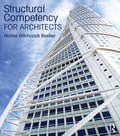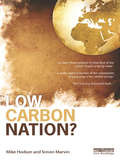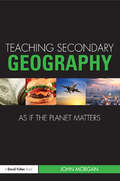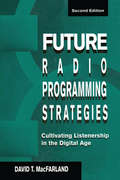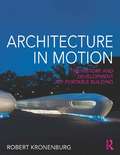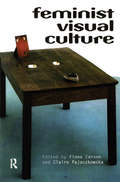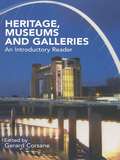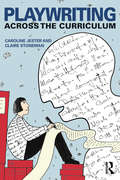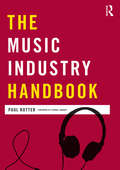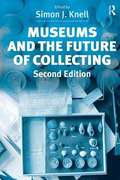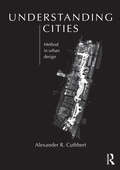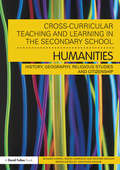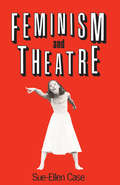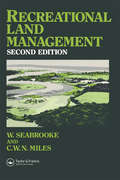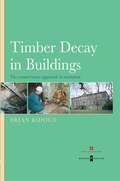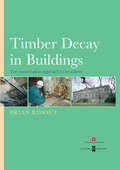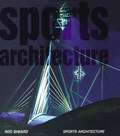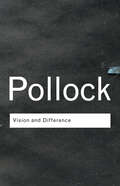- Table View
- List View
Structural Competency for Architects
by Hollee Hitchcock BeckerStructural Competency for Architects is a comprehensive volume covering topics from structural systems and typologies to statics, strength of materials, and component design. The book includes everything you need to know about structures for the design of components, as well as the logic for design of structural patterns, and selection of structural typologies. Organized into six key modules, each chapter includes examples, problems, and labs, along with an answer key available on our website, so that you learn the fundamentals. Structural Competency for Architects will also help you pass your registration examinations.
Low Carbon Nation?
by Mike Hodson Simon MarvinWhat does the transition to a Low Carbon Britain mean for the future development of cities and regions across the country? Does it reinforce existing ‘business as usual’ or create new transformational opportunities? Low Carbon Nation? takes an interdisciplinary approach to tackle this critical question, by looking across the different dimensions of technological, scientific, social and economic change within the diverse city and regional contexts of the UK. Hodson and Marvin set out how the transition to low carbon futures needs to be understood as a dual response to the wider financial and economic crisis and to critical ecological concerns about the implications of global climate change. The book develops a novel framework for understanding how the transition to low carbon is informed by historical legacies that shape the geographical, political and cultural dimensions of low carbon responses. Through a programme of research in Scotland, Wales, the North East of England, Greater London, and Greater Manchester, the authors set out different styles of low carbon urban and regional response. Through in-depth illustration of this in newly devolved nations, an old industrial region, a global city-region and in an entrepreneurial city, international lessons can be drawn about the limits and the unrealised opportunities of low carbon transition. This book is key reading for students on geography, economics, planning and social science degrees, as well as those studying sustainability in related contexts trying to understand the urban and regional politics of low carbon transition. It is also an essential resource for policymakers, public officials, elected representatives, environmentalists and business leaders concerned with shaping the direction and type of transition.
Low Carbon Nation?
by Mike Hodson Simon MarvinWhat does the transition to a Low Carbon Britain mean for the future development of cities and regions across the country? Does it reinforce existing ‘business as usual’ or create new transformational opportunities? Low Carbon Nation? takes an interdisciplinary approach to tackle this critical question, by looking across the different dimensions of technological, scientific, social and economic change within the diverse city and regional contexts of the UK. Hodson and Marvin set out how the transition to low carbon futures needs to be understood as a dual response to the wider financial and economic crisis and to critical ecological concerns about the implications of global climate change. The book develops a novel framework for understanding how the transition to low carbon is informed by historical legacies that shape the geographical, political and cultural dimensions of low carbon responses. Through a programme of research in Scotland, Wales, the North East of England, Greater London, and Greater Manchester, the authors set out different styles of low carbon urban and regional response. Through in-depth illustration of this in newly devolved nations, an old industrial region, a global city-region and in an entrepreneurial city, international lessons can be drawn about the limits and the unrealised opportunities of low carbon transition. This book is key reading for students on geography, economics, planning and social science degrees, as well as those studying sustainability in related contexts trying to understand the urban and regional politics of low carbon transition. It is also an essential resource for policymakers, public officials, elected representatives, environmentalists and business leaders concerned with shaping the direction and type of transition.
Teaching Secondary Geography as if the Planet Matters
by John Morgan'Teaching Geography as if the Planet Matters provides a timely outline of powerful knowledge and arguments that will be needed to counter a strengthening of current curriculum orthodoxies. Not until school geography undergoes the revolution that this book outlines can it honestly claim to be contributing to more sustainable futures.' - John Huckle, Visiting Fellow at the University of York and was formerly Principal Lecturer in Educaton at De Montfort University. We are surrounded by images and warnings of impending environmental disaster. Climate change, famine, population growth and urban crisis coupled with more recent financial chaos all threaten our sense of what it will be like to live in the future. This thought-provoking text looks at how Geography teachers can develop approaches to curriculum and learning which help students understand the nature of the contemporary world. It sets out a model for teaching and learning that allows teachers to examine existing approaches to teaching and draw upon the insights of geography as a discipline to deepen students’ understanding of urban futures, climate change, ‘geographies of food’ and the ‘geographies of the credit crunch’. Features include: examples of suggested teaching activities questions and activities for further study detailed case studies sources of further reading and information The true worth of a school subject is revealed in how far it can account for and respond to the major issues of the time. The issue of the environment cuts across subject boundaries and requires an interdisciplinary response. Geography teachers are part of that response and they have a crucial role in helping students to respond to environmental issues and representations.
Teaching Secondary Geography as if the Planet Matters
by John Morgan'Teaching Geography as if the Planet Matters provides a timely outline of powerful knowledge and arguments that will be needed to counter a strengthening of current curriculum orthodoxies. Not until school geography undergoes the revolution that this book outlines can it honestly claim to be contributing to more sustainable futures.' - John Huckle, Visiting Fellow at the University of York and was formerly Principal Lecturer in Educaton at De Montfort University. We are surrounded by images and warnings of impending environmental disaster. Climate change, famine, population growth and urban crisis coupled with more recent financial chaos all threaten our sense of what it will be like to live in the future. This thought-provoking text looks at how Geography teachers can develop approaches to curriculum and learning which help students understand the nature of the contemporary world. It sets out a model for teaching and learning that allows teachers to examine existing approaches to teaching and draw upon the insights of geography as a discipline to deepen students’ understanding of urban futures, climate change, ‘geographies of food’ and the ‘geographies of the credit crunch’. Features include: examples of suggested teaching activities questions and activities for further study detailed case studies sources of further reading and information The true worth of a school subject is revealed in how far it can account for and respond to the major issues of the time. The issue of the environment cuts across subject boundaries and requires an interdisciplinary response. Geography teachers are part of that response and they have a crucial role in helping students to respond to environmental issues and representations.
Future Radio Programming Strategies: Cultivating Listenership in the Digital Age
by David MacFarlandFundamental beliefs is what the reader will be exploring here -- a common understanding of what the radio enterprise should be about: entertainment and information. A major thrust of this book is to arrive at a set of fundamental beliefs about the values and realities of the radio business in regard to entertainment programming -- a set of beliefs that may or may not be right, true, or forever, but that might at least provide a basis for developing programming strategies. This second edition of Future Radio Programming Strategies seeks to answer the question: "What do listeners really want from radio?" Some of the answers are derived from "users-and-gratifications" research in the mass media. Instead of focusing on what mass media do to people, the users-and-gratifications perspective seeks to discover what people do with mass media. The functionalist viewpoint of such research basically says that a medium is best defined by how people use it. Having looked at some of the audience research that comes from sources other than the standard ratings companies, the book then goes on to demonstrate new ways that formats, production procedures, and announcing styles can meet audience needs and desires. Although the volume concludes with several original methods for selecting and presenting airplay music based on the audience's moods and emotional needs, it does not insist upon a singular, formulaic approach for constructing or modifying a music format. Instead, it attempts to involve the reader in thinking through the process of format development. Two audio tapes are also available for use with the book. The tapes contain nearly 3 hours of important, detailed information and provocative points from the book. Exclusive audio examples include: * the sense of acoustic space in music; * hi-fi versus lo-fi listening environments; * subjective perception of the announcer's distance from the listener; * audio editing rates; * comparison of luxury versus inexpensive car listening experiences; and * the components of emotions that are expressed vocally. The tapes also include new sections about the threats to traditional radio from specialized digital audio services, competition for the listener's attention from computer-based media, and additional proof of how music can be chosen on the basis of listeners' emotional reactions and mood needs.
Architecture in Motion: The history and development of portable building
by Robert KronenburgThe idea that architecture can be portable is one that grabs the imagination of both designers and the people who use it, perhaps because it so often forecasts a dynamic and creative solution to the complex problems of our contemporary mobile society, while at the same time dealing with issues of practicality, economy and sustainability. Architecture in Motion examines the development of portable, transportable, demountable and temporary architecture from prehistory to the present day. From familiar vernacular models such as the tent, mobile home and houseboat, to ambitious developments in military and construction engineering, all aspects of portable building are considered. Building on his earlier works Portable Architecture and Houses in Motion, Robert Kronenburg compares traditional forms of building, current commercial products and the work of innovative designers, and examines key contemporary portable buildings to reveal surprising, exciting and imaginative examples. He explores the philosophical and technological issues raised by these experimental and futuristic prototypes. By understanding the nature of transitory architecture, a new ecologically aware design strategy can be developed to prioritise buildings that 'tread lightly on the earth' and still convey the sense of identity and community necessary for an established responsible society. This book provides a unique insight into this pivotal field of design.
Architecture in Motion: The history and development of portable building
by Robert KronenburgThe idea that architecture can be portable is one that grabs the imagination of both designers and the people who use it, perhaps because it so often forecasts a dynamic and creative solution to the complex problems of our contemporary mobile society, while at the same time dealing with issues of practicality, economy and sustainability. Architecture in Motion examines the development of portable, transportable, demountable and temporary architecture from prehistory to the present day. From familiar vernacular models such as the tent, mobile home and houseboat, to ambitious developments in military and construction engineering, all aspects of portable building are considered. Building on his earlier works Portable Architecture and Houses in Motion, Robert Kronenburg compares traditional forms of building, current commercial products and the work of innovative designers, and examines key contemporary portable buildings to reveal surprising, exciting and imaginative examples. He explores the philosophical and technological issues raised by these experimental and futuristic prototypes. By understanding the nature of transitory architecture, a new ecologically aware design strategy can be developed to prioritise buildings that 'tread lightly on the earth' and still convey the sense of identity and community necessary for an established responsible society. This book provides a unique insight into this pivotal field of design.
Feminist Visual Culture
by Fiona Carson Claire PajaczkowskaFirst Published in 2001. Routledge is an imprint of Taylor & Francis, an informa company.
Heritage, Museums and Galleries: An Introductory Reader (PDF)
by Gerard CorsaneThis reader provides a starting point and introductory resource for anyone wishing to engage with certain key issues relating to the heritage, museums and galleries sector.
Heritage, Museums and Galleries: An Introductory Reader
by Gerard CorsaneThis reader provides a starting point and introductory resource for anyone wishing to engage with certain key issues relating to the heritage, museums and galleries sector.
Playwriting Across The Curriculum
by Claire Stoneman Caroline JesterFirst Published in 2012. Routledge is an imprint of Taylor & Francis, an informa company.
The Music Industry Handbook (PDF)
by Paul RutterThe Music Industry Handbook provides a clear introduction to how the music industry works, unpacking the complex structures within the industry and mapping it as it exists today. Paul Rutter introduces readers to key industry sectors in an easy-to-digest format, then goes on to explore the essential elements of these sectors and how they work in practice. The Music Industry Handbook opens with a foreword by Feargal Sharkey, and boasts interviews and profiles with major figures in the industry such as Pete Astor, Marius Carboni, Stu Lambert, Simon May and Mike Smith, offering insightful background knowledge into working in the music business. The book has a practical focus, yet it also discusses relevant theoretical perspectives and chronology, and thus avoids being simply an expos'. In a fast-evolving market, the author offers advice on keeping up-to-date with future developments, and guides those wishing to enter the industry on the myriad of roles available. The Music Industry Handbook provides valuable business strategies and start-up' tools for those that wish to set up independent music ventures, and offers clear explanations of numerous issues including legal trading, ownership and IP music law, copyright, exploitation and protective measures, gatekeeping and hidden music income streams. Throughout the book are suggestions for further reading and valuable source links that guide the reader towards key music industry and media texts, as well as a comprehensive glossary of industry-related terms. The Music Industry Handbook will be invaluable to both new and veteran music-makers, promoters, musicians and managers, and students who want to build confident futures within the music industry.
Museums And The Future Of Collecting
by Simon J. KnellCollecting is a key function of museums. Its apparent simplicity belies a complexity of questions and issues which make all collecting imprecise and unrepresentative. This book exposes the many meanings of collections, the different perspectives taken by different cultures, and the institutional response to the collecting problem. One major concern is omission, whether this be determined by politics, professional ethics, the law or social agenda. How did curators collect during the war in Croatia? What were the problems of trying to collect the #65533;old#65533; South Africa when the new one was born? Can museums collect from groups which seem to #65533;deviate#65533; from society#65533;s norms? How has the function of museums affected the practices of international trade? Can museums collect successfully if collecting agenda are being set externally? Museums and the Future of Collecting encourages museums to move away from the collecting of isolated tokens; to move beyond the collecting policy and to understand more clearly the intellectual function of what they do. Here examples are given from Australia, Sweden, Canada, Spain, Britain and Croatia which provide this intellectual understanding and many practical tools for evaluating a future collecting strategy.
Understanding Cities: Method in Urban Design
by Alexander CuthbertUnderstanding Cities is richly textured, complex and challenging. It creates the vital link between urban design theory and praxis and opens the required methodological gateway to a new and unified field of urban design. Using spatial political economy as his most important reference point, Alexander Cuthbert both interrogates and challenges mainstream urban design and provides an alternative and viable comprehensive framework for a new synthesis. He rejects the idea of yet another theory in urban design, and chooses instead to construct the necessary intellectual and conceptual scaffolding for what he terms 'The New Urban Design'. Building both on Michel de Certeau's concept of heterology – 'thinking about thinking' – and on the framework of his previous books Designing Cities and The Form of Cities, Cuthbert uses his prior adopted framework – history, philosophy, politics, culture, gender, environment, aesthetics, typologies and pragmatics – to create three integrated texts. Overall, the trilogy allows a new field of urban design to emerge. Pre-existing and new knowledge are integrated across all three volumes, of which Understanding Cities is the culminating text.
Understanding Cities: Method in Urban Design
by Alexander CuthbertUnderstanding Cities is richly textured, complex and challenging. It creates the vital link between urban design theory and praxis and opens the required methodological gateway to a new and unified field of urban design. Using spatial political economy as his most important reference point, Alexander Cuthbert both interrogates and challenges mainstream urban design and provides an alternative and viable comprehensive framework for a new synthesis. He rejects the idea of yet another theory in urban design, and chooses instead to construct the necessary intellectual and conceptual scaffolding for what he terms 'The New Urban Design'. Building both on Michel de Certeau's concept of heterology – 'thinking about thinking' – and on the framework of his previous books Designing Cities and The Form of Cities, Cuthbert uses his prior adopted framework – history, philosophy, politics, culture, gender, environment, aesthetics, typologies and pragmatics – to create three integrated texts. Overall, the trilogy allows a new field of urban design to emerge. Pre-existing and new knowledge are integrated across all three volumes, of which Understanding Cities is the culminating text.
Cross-Curricular Teaching and Learning in the Secondary School… Humanities: History, Geography, Religious Studies and Citizenship
by Simon Harrison Richard Harris Richard McFahnWhat is the role of the humanities in the modern school? Should geography, history, RE and Citizenship teachers remain faithful to long-standing subject cultures and pedagogies? Or is there another way to consider how the curriculum, and the notion of individual subjects and teachers’ pedagogy, could be constructed? Drawing on case studies taken from a range of innovative secondary schools, and interrogating the use of cross-curricular approaches in UK schools, Cross-Curricular Teaching and Learning in Humanities constructs a research based pedagogy with practical steps for students and teachers as they consider how cross-curricular approaches can be implemented in their own subject areas. Key features include: Clear theoretical frameworks for cross-curricular processes of teaching and learning in the humanities Lively and engaging text that blends key issues with stories of current practice An analysis of the use of assessment, enquiry, and pupil talk as key components in building a cross-curricular approach to the humanities Practical and reflective tasks that enable to reader to apply their reading to day to day practice, alongside links to professional standards Summaries of key research linked to suggestions for further reading Professional development activities to promote cross-curricular dialogue Part of the Cross-Curricular Teaching and Learning in the Secondary School series, this timely interdisciplinary textbook is essential reading for all students on Initial Teacher Training courses and practising teachers looking to holistically introduce cross-curricular themes and practices in secondary Humanities teaching.
Feminism and Theatre
by Sue-Ellen CaseThis classic study is both an introduction to, and an overview of, the relationship between feminism and theatre.
Feminism and Theatre
by Sue-Ellen CaseThis classic study is both an introduction to, and an overview of, the relationship between feminism and theatre.
Recreational Land Management
by C.W.N. Miles Professor C Miles W. SeabrookeThe aim of this book is to construct a framework of understanding for those coming to the field of recreational land management from a non-land management discipline.
Timber Decay in Buildings: The Conservation Approach to Treatment
by Brian RidoutThis is the first book to tackle all the issues relating to timber decay. It presents the facts and explores timber decay problems through case studies. These are illustrated with clear self-explanatory photographs for the reader to use as a diagnostic aid. Section 1 discusses timber as a living material, Section 2 deals with decay organisms and their habitat requirements. Section 3 moves on to the building as an environment for timber and discusses the ways in which wood responds to moisture change. Section 4 ends with an approach to timber decay which integrates knowledge on the decay organism, its requirements and natural predators with appropriate and targeted chemical treatments.
Timber Decay in Buildings: The Conservation Approach to Treatment
by Brian RidoutThis is the first book to tackle all the issues relating to timber decay. It presents the facts and explores timber decay problems through case studies. These are illustrated with clear self-explanatory photographs for the reader to use as a diagnostic aid. Section 1 discusses timber as a living material, Section 2 deals with decay organisms and their habitat requirements. Section 3 moves on to the building as an environment for timber and discusses the ways in which wood responds to moisture change. Section 4 ends with an approach to timber decay which integrates knowledge on the decay organism, its requirements and natural predators with appropriate and targeted chemical treatments.
Sports Architecture
by Rod SheardThis book offers a rare chance to understand how sport and architecture come together to create an outstanding building type - a symbol of our times. Rod Sheard shares the experience and expertise of HOK LOBB in this beautifully illustrated book, offering practical advice and guidance on commissioning, designing and managing sports venues around the world. The award-winning work of this firm includes the Millennium Stadium, Cardiff, the Wembley National Stadium, London and the Stadium Australia in Sydney, commissioned for the Olympic Games 2000.
Sports Architecture
by Rod SheardThis book offers a rare chance to understand how sport and architecture come together to create an outstanding building type - a symbol of our times. Rod Sheard shares the experience and expertise of HOK LOBB in this beautifully illustrated book, offering practical advice and guidance on commissioning, designing and managing sports venues around the world. The award-winning work of this firm includes the Millennium Stadium, Cardiff, the Wembley National Stadium, London and the Stadium Australia in Sydney, commissioned for the Olympic Games 2000.
Vision and Difference: Feminism, Femininity and Histories of Art
by Griselda PollockGriselda Pollock provides concrete historical analyses of key moments in the formation of modern culture to reveal the sexual politics at the heart of modernist art. Crucially, she not only explores a feminist re-reading of the works of canonical male Impressionist and Pre-Raphaelite artists including Edgar Degas and Dante Gabriel Rossetti, but also re-inserts into art history their female contemporaries - women artists such as Berthe Morisot and Mary Cassatt. Pollock discusses the work of women artists such as Mary Kelly and Yve Lomax, highlighting the problems of working in a culture where the feminine is still defined as the object of the male gaze. Now published with a new introduction, Vision and Difference is as powerful as ever for all those seeking not only to understand the history of the feminine in art, but also to develop new strategies for representation for the future.
